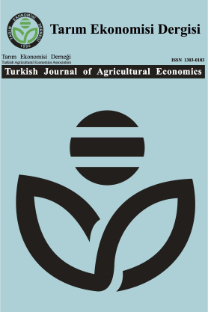İZMİR VE MANİSA'DA İŞLENEN DOMATESİN SOSYAL YAŞAM DÖNGÜSÜ ANALİZİ
Social Life Cycle Analysis of Processed Tomato in İzmir and Manisa
___
KAYNAKLAR Abak, K., Erkan, O., Eser, B., Halloran, N., Yanmaz, R., Sarı, N., Ekiz H. 2000. Sebze Tarımında 2000lerde Üretim Hedefleri.http://www.zmo.org.tr/resimler/ekler/d3d9e73 d8b70698_ek.pdf (Erişim: 17 Aralık 2014) Abdelhakim, T. 2009. Economie de développement rural : les nouveaux paradigmes, Projet Formder. Formder Yayın, Montpellier. Belem, G., 2005. Lanalyse du cycle de vie comme outil de développement durable, http://www.crsdd.uqam.ca/Pages/docs/pdfCahiersRecher che/08-2005.pdf (Erişim : 17 Aralık 2014) Ekins, P., Dresner, S., Dahlström, K. 2008. The four-capital method of sustainable development evaluation. European Environment. 18: 63-80. Engindeniz, S., Coşar, G. 2013. İzmirde Domates Üretiminin Ekonomik ve Teknik Etkinlik Analizi. Ege Üniv. Ziraat Fak. Dergisi. 50 (1): 67-75. Garrabé M., 2007. Production de capital social des OESS, http://michel-garrabe.com/cours/m1_ch12.pdf , (Erişim: 29 Kasım 2014). Garrabé, M., Feschet, P. 2013. Un cas particulier: lACV sociale des capacités. Cirad. (éd.), ACV Sociales Effets socio-économique des chaînes valeurs. Publication Cirad, Montpellier, 87-117. İzmir Tarım İl Müdürlüğü, 2013. İzmir ili 2013 yılı sebzeler ekiliş, üretim, verim değeri. http://izmir.tarim.gov.tr/Menu/15/Istatistikler (Erişim: 29 Kasım 2014) Jørgensen, A., Le Bocq, A., Nazarkina, L., Hauschild, M. 2008. Methodologies for Social Life Cycle Assessment. Int J LCA. 13 (2) 96103 Keskin, G. 2010.Türkiyede Domates Salça Sanayi ve İç Piyasada Fiyat Değişimleri. YYÜ Tar Bilg.Der. 20(3):214-221 Keskin, G. 2012. Durum ve Tahmin: Domates ve domates salçası 2011-2012. http://www.tepge.gov.tr/upload/attachments/domates201 2.pdf (Erişim: 17 Aralık 2014) Macombe, C. 2013. Comment prévoir les effets et impacts sociaux. ACV Sociales Effets socio-économique des chaînes valeurs. Yayın Cirad, Montpellier, 142-153 Macombe, C., Lagarde, V. 2013. Le fonctionnement du cycle de vie social et les périmètres de létude. Cirad. (éd.), ACV Sociales Effets socio-économique des chaînes valeurs. Publication Cirad, Montpellier, 53-68 Patoine, M.F. 2012. Guide sur lanalyse du cycle de vie et la production dune déclaration environnementale de type III, Yüksek Lisans Tezi, Université de Sherbrooke, s.4. Sarısaçlı, İ. E. 2008. Salça. http://www.tgdf.org.tr/turkce/tgdfraporlari/igmdomatessa lcasi.pdf (Erişim: 17 Aralık 2014) Sen, A. 2000. Development as Freedom. 4th ed. Knopf, New York. Ulukan, U. 2009. Türkiye Tarımında Yapısal Dönüşüm ve Sözleşmeli Çiftçilik: Bursa Örneği. Sosyal araştırmalar Vakfı Yayınları, İstanbul. UNEP-SETAC. 2009. Guidelines for Social Life Cycle Assesment of Products- ISSN: 1303-0183
- Yayın Aralığı: 2
- Başlangıç: 1992
- Yayıncı: Tarım Ekonomisi Dergisi
İZMİR İLİNDE ARICILIĞIN EKONOMİK YÖNLERİ VE SORUNLARI
SAİT ENGİNDENİZ, Kubilay UÇAR, Cansu BAŞARAN
İZMİR VE MANİSA'DA İŞLENEN DOMATESİN SOSYAL YAŞAM DÖNGÜSÜ ANALİZİ
SERBEST TİCARET ANLAŞMALARININ TÜRK DIŞ TİCARETİ ÜZERİNE ETKİLERİ
OSMAN MURAT KOÇTÜRK, Aslıhan KOCAEFE
TARIMDA EĞİTİM VE İŞGÜCÜ VERİMLİLİĞİ İLİŞKİSİ: BÖLGESEL FARKLILIKLAR
ONUR SUNGUR, Recep KOÇ, MURAT ALİ DULUPÇU
ÇELTİK ÜRETİMİNDE KİMYASAL İLAÇ KULLANIMINI ETKİLEYEN FAKTÖRLERİN ANALİZİ: SAMSUN İLİ ÖRNEĞİ
AHMET SEMİH UZUNDUMLU, Göksel TOZLU, Okan GEDİKLİ
TÜRKİYE VE RUSYA TARIMSAL TİCARETİNİN POLİTİKA DEĞİŞİMİ AÇISINDAN DEĞERLENDİRİLMESİ
İSTANBUL İLİ KENTSEL ALANDA TÜKETİCİLERİN AÇIK VE PAKET SÜT TÜKETİM ALIŞKANLIKLARI
